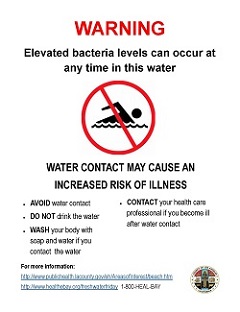About Fresh Water Swim Areas
Swimming and other recreation activities in rivers and streams may seem like a good way to keep active, however, there can be risks associated with these waters. The water can be contaminated with bacteria, other harmful organisms, and unknown contaminants.
Designated Swim Areas
Los Angeles County maintains three designated swim beaches that provide restroom facilities, lifeguards, and chlorinators to reduce the risk of elevated bacteria counts and harmful algae blooms. These swim beaches are located at Puddingstone Lake, Santa Fe Dam, and Castaic Lake and are normally open for swim season from Memorial Day to Labor Day.
Pyramid Lake, in the Los Padres National Forest and part of the California State Water Project, also has swim areas. However, these are not chlorinated and are subject to periodic algae blooms in the summertime.
The Recreational Waters program provides information here for the public to make informed decision about swimming in fresh water. The designated swim beaches are monitored throughout the swim season.
Hazards at Lakes, Rivers, Swimming Holes, and Other Bodies of Water
There are many areas throughout LA County used for water contact that are not designated swim areas, such as lakes, rivers, swimming holes, creeks, ponds, storm water collection and flood control areas. These areas usually do not have associated restrooms, nor are they staffed with lifeguards. Additionally, the water in these areas is affected by runoff that is often contaminated. These waters are regularly tested by LA County Public Works Watershed Division and other agencies/organizations, and often times have been found to have high bacteria counts. The bacteria can come from both animal and human sources. The high counts indicate that there may be bacteria in the water that can cause illness such as gastrointestinal illness, skin rash, respiratory illness, and infections. Risk of becoming ill is increased for young children and the elderly as well as for those with compromised immune systems. Rain events increase runoff and bacteria levels, and increase the risk of becoming ill from water contact. Also some areas may become flooded and create a safety and drowning hazard during and after rain events. In addition, other unknown harmful organisms or toxins may occur in these open waters at any time.
Protect Yourself at lakes, rivers, swimming holes and other freshwater sites:
Evaluate Your Risk:
- Prior to your visit, check site specific water quality history (Check Heal the Bay and/or Los Angeles County Public Works Watershed Page for exceedance levels). If the site had high bacterial counts, it is recommended that you not swim or come into contact with the water. If no data is available for your specific site, then the risks are not known.
- High bacteria count can happen at any time and risk increases for the 72 hours after significant rainfall
- Check for any posted warning signs. Although most locations will not have these signs, certain areas with a history of high bacterial counts may have warning signs posted.
- Illness risk increases with more water contact to your face, mouth, nose, and ears. Therefore, swimming and getting your head in the water is riskier than wading in the water, and swallowing the water is riskier than getting splashed on the skin. Swimming and water contact does not necessarily mean you will get sick, especially if you avoid swallowing any water and rinse with soap and water after coming in contact with the water.
Swimming and water contact is not recommended in areas known to exceed bacterial limits (check Heal the Bay and/or Los Angeles County Public Works Watershed Page for exceedance levels). During swim season, it would be much safer to use designated swim areas instead of other freshwater areas. If you choose to swim in undesignated freshwater sites, avoid swallowing any water and rinse with soap and water after coming in contact with the water. If you become ill following your swim activity, you should contact your doctor.

Boating and Fishing: Avoid water contact and avoid hand to face contact. Rinse off with soap and water if there is water contact.
Related Links
- Heal the Bay Fresh Water Information Page
- Council of Watershed Health
- Mountain Recreation and Conservancy Authority
- Los Angeles County Public Works Watershed
- Los Angeles City Sanitation Water Quality
- Harmful Algae Bloom Information
- Pyramid Lake Algal Bloom Press Release
- Pyramid Lake Caution Sign
- Castaic Lake Caution
Report a Problem
If you observe code violations or visible signs that something is wrong with the water such as a sewage spill at one of the designated swim beaches or would like to file a complaint, you may report this issue by calling the Recreational Waters Program (626) 430-5360 or File a Complaint Online.




